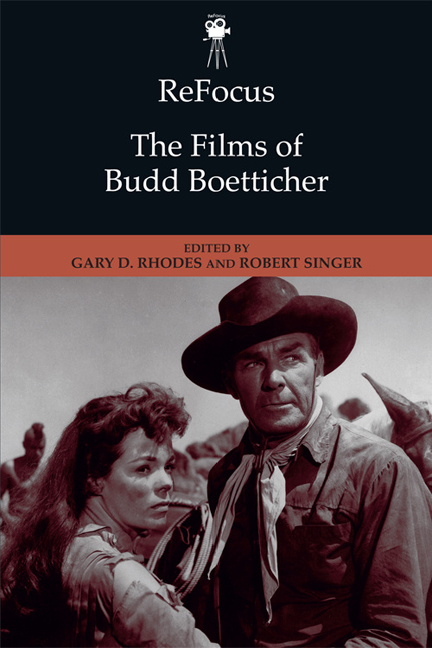Book contents
- Frontmatter
- Contents
- Notes on Contributors
- Dedication
- Introduction
- Part 1 The Non-Westerns
- Part 1 Introduction
- 1 “I never did think he was crazy”: Mystery and Criminality in Boetticher's Psychological Noirs
- 2 On Ethics and Style in Bullfighter and the Lady (1951)
- 3 Domestic Tension and Male Hysteria: The Killer is Loose (1956)
- 4 The Killer is Loose (1956) and the Televisual Dissolution of Film Noir
- 5 Adventures on the Small Screen: Boetticher, Warner Bros., and Maverick
- 6 The Signifying Heel: Boetticher's The Rise and Fall of Legs Diamond (1960)
- Part 2 The Westerns
- Index
Part 1 - Introduction
from Part 1 - The Non-Westerns
Published online by Cambridge University Press: 22 December 2017
- Frontmatter
- Contents
- Notes on Contributors
- Dedication
- Introduction
- Part 1 The Non-Westerns
- Part 1 Introduction
- 1 “I never did think he was crazy”: Mystery and Criminality in Boetticher's Psychological Noirs
- 2 On Ethics and Style in Bullfighter and the Lady (1951)
- 3 Domestic Tension and Male Hysteria: The Killer is Loose (1956)
- 4 The Killer is Loose (1956) and the Televisual Dissolution of Film Noir
- 5 Adventures on the Small Screen: Boetticher, Warner Bros., and Maverick
- 6 The Signifying Heel: Boetticher's The Rise and Fall of Legs Diamond (1960)
- Part 2 The Westerns
- Index
Summary
American film director Budd Boetticher's body of work extends well beyond the Westerns for which he is best known.
In fact, Boetticher's earliest and productive work was located in other industrial film genres. While he directed retakes for other films as early as 1942, Boetticher's first accredited job as director was for One Mysterious Night (1944), a B movie at Columbia Pictures featuring the escapades of detective Boston Blackie (Chester Morris). This project was followed by a number of other crime movies, including The Missing Juror (1944), Escape in the Fog (1945), Assigned to Danger (1948), and Behind Locked Doors (1948). Boetticher's directorial work also extended to a number of other established genres, including the documentary, in his 1945 short The Fleet that Came to Stay, the j.d. (juvenile delinquent) film, Youth on Trial (1945), the comedy, A Guy, a Gal and a Pal (1945), and the adventure film, Killer Shark (1950). In all these films, Boetticher's on-screen credit reflects his true birth name: either “Oscar Boetticher, Jr.” or simply “Oscar Boetticher.”
By 1951, his transition to the on-screen credit “Budd Boetticher” came with his transition to a director of critically noted films. The initial film was Bullfighter and the Lady (1951). It might be tempting to suggest that the transition of screen credits from Oscar Boetticher, Jr. to Budd Boetticher is somehow indicative of a transition from the director of derivative, industrial staples of non-Westerns to the celebrated auteur of Western masterpieces. While that would make a simple and perhaps compelling story, it would also be extremely unfair and critically unsound to neglect the entire Boetticher canon.
Not only did Boetticher forge ahead as the yeoman-like director of episodes of a number of television programs, including seven episodes of Public Defender in 1954, and films, including Red Ball Express (1952), and both City Beneath the Sea and East of Sumatra (1953), he also created a small number of classics in film genres other than the Western for which he is well known, most notably The Killer is Loose (1956) and The Rise and Fall of Legs Diamond (1960). Moreover, Boetticher's career did not culminate with a Western film; instead, it concludes with framing a personal obsession, which he prominently notes in his autobiography, one that took him back to the days of Bullfighter and the Lady.
- Type
- Chapter
- Information
- ReFocus: The Films of Budd Boetticher , pp. 13 - 14Publisher: Edinburgh University PressPrint publication year: 2017

